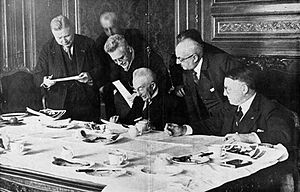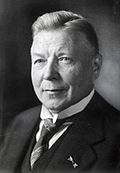Third Colijn cabinet | |
|---|---|
| Cabinet of the Netherlands | |
 Meeting of the Third Colijn cabinet in 1936 | |
| Date formed | 31 July 1935 |
| Date dissolved | 24 June 1937 (Demissionary from 25 May 1937) |
| People and organisations | |
| Head of state | Queen Wilhelmina |
| Head of government | Hendrikus Colijn |
| Deputy head of government | Josef van Schaik (Unofficially) |
| No. of ministers | 10 |
| Member party | Roman Catholic State Party (RKSP) Anti-Revolutionary Party (ARP) Christian Historical Union (CHU) Liberal State Party (LSP) Free-thinking Democratic League (VDB) |
| Status in legislature | Centre-right Majority government |
| History | |
| Legislature terms | 1933–1937 |
| Predecessor | Second Colijn cabinet |
| Successor | Fourth Colijn cabinet |
| Part of the Politics series |
 |
|---|
| |
The Third Colijn cabinet was the cabinet of the Netherlands from 31 July 1935 until 24 June 1937. The cabinet was formed by the political parties Roman Catholic State Party (RKSP), Anti-Revolutionary Party (ARP), Christian Historical Union (CHU), Liberal State Party (LSP) and the Free-thinking Democratic League (VDB) after the resignation of the Second Colijn cabinet on 23 July 1935. The centre-right cabinet was a majority government in the House of Representatives and was a continuation of the previous Cabinet Colijn II. It was the third of five cabinets of Hendrikus Colijn, the Leader of the Anti-Revolutionary Party as Prime Minister. [1] [2] [3] [4] [5]









